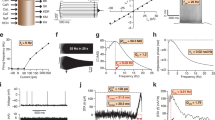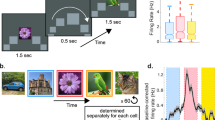Abstract
According to the temporal coding hypothesis1, neurons encode information by the exact timing of spikes. An example of temporal coding is the hippocampal phase precession phenomenon, in which the timing of pyramidal cell spikes relative to the theta rhythm shows a unidirectional forward precession during spatial behaviour2,3. Here we show that phase precession occurs in both spatial and non-spatial behaviours. We found that spike phase correlated with instantaneous discharge rate, and precessed unidirectionally at high rates, regardless of behaviour. The spatial phase precession phenomenon is therefore a manifestation of a more fundamental principle governing the timing of pyramidal cell discharge. We suggest that intrinsic properties of pyramidal cells have a key role in determining spike times, and that the interplay between the magnitude of dendritic excitation and rhythmic inhibition of the somatic region is responsible for the phase assignment of spikes4,5.
This is a preview of subscription content, access via your institution
Access options
Subscribe to this journal
Receive 51 print issues and online access
$199.00 per year
only $3.90 per issue
Buy this article
- Purchase on Springer Link
- Instant access to full article PDF
Prices may be subject to local taxes which are calculated during checkout




Similar content being viewed by others
References
Singer, W. Synchronization of cortical activity and its putative role in information processing and learning. Annu. Rev. Physiol. 55, 349–374 (1993)
O'Keefe, J. & Recce, M. L. Phase relationship between hippocampal place units and the EEG theta rhythm. Hippocampus 3, 317–330 (1993)
Skaggs, W. E., McNaughton, B. L., Wilson, M. A. & Barnes, C. A. Theta phase precession in hippocampal neuronal populations and the compression of temporal sequences. Hippocampus 6, 149–172 (1996)
Magee, J. C. Dendritic mechanisms of phase precession in hippocampal CA1 pyramidal neurons. J. Neurophysiol. 86, 528–532 (2001)
Kamondi, A., Acsady, L., Wang, X. J. & Buzsaki, G. Theta oscillations in somata and dendrites of hippocampal pyramidal cells in vivo: activity-dependent phase-precession of action potentials. Hippocampus 8, 244–261 (1998)
Adrian, E. D. & Zotterman, Y. The impulses produced by sensory nerve endings. Part 2. The response of a single end organ. J. Physiol. (Lond.) 61, 151–171 (1926)
Gray, C. M. & Singer, W. Stimulus-specific neuronal oscillations in orientation columns of cat visual cortex. Proc. Natl Acad. Sci. USA 86, 1698–1702 (1989)
Hopfield, J. J. Pattern recognition computation using action potential timing for stimulus representation. Nature 376, 33–36 (1995)
Buzsaki, G. & Chrobak, J. J. Temporal structure in spatially organized neuronal ensembles: a role for interneuronal networks. Curr. Opin. Neurobiol. 5, 504–510 (1995)
Vaadia, E. et al. Dynamics of neuronal interactions in monkey cortex in relation to behavioural events. Nature 373, 515–518 (1995)
Riehle, A., Grun, S., Diesmann, M. & Aertsen, A. Spike synchronization and rate modulation differentially involved in motor cortical function. Science 278, 1950–1953 (1997)
O'Keefe, J. & Nadel, L. The Hippocampus as a Cognitive Map (Clarendon, Oxford, 1978)
Burgess, N., Recce, M. & O'Keefe, J. A model of hippocampal function. Neural Networks 7, 1065–1081 (1994)
Quirk, M. C., Blum, K. I. & Wilson, M. A. Experience-dependent changes in extracellular spike amplitude may reflect regulation of dendritic action potential back-propagation in rat hippocampal pyramidal cells. J. Neurosci. 21, 240–248 (2001)
Harris, K. D., Hirase, H., Leinekugel, X., Henze, D. A. & Buzsaki, G. Temporal interaction between single spikes and complex spike bursts in hippocampal pyramidal cells. Neuron 32, 141–149 (2001)
Hirase, H., Czurko, A., Csicsvari, J. & Buzsaki, G. Firing rate and theta-phase coding by hippocampal pyramidal neurons during ‘space clamping’. Eur. J. Neurosci. 11, 4373–4380 (1999)
Csicsvari, J., Hirase, H., Mamiya, A. & Buzsaki, G. Ensemble patterns of hippocampal CA3-CA1 neurons during sharp wave-associated population events. Neuron 28, 585–594 (2000)
Csicsvari, J., Hirase, H., Czurko, A. & Buzsaki, G. Reliability and state dependence of pyramidal cell-interneuron synapses in the hippocampus: an ensemble approach in the behaving rat. Neuron 21, 179–189 (1998)
Harris, K. D., Henze, D. A., Csicsvari, J., Hirase, H. & Buzsaki, G. Accuracy of tetrode spike separation as determined by simultaneous intracellular and extracellular measurements. J. Neurophysiol. 84, 401–414 (2000)
Csicsvari, J., Hirase, H., Czurko, A., Mamiya, A. & Buzsaki, G. Oscillatory coupling of hippocampal pyramidal cells and interneurons in the behaving rat. J. Neurosci. 19, 274–287 (1999)
Henze, D. A. & Buzsaki, G. Action potential threshold of hippocampal pyramidal cells in vivo is increased by recent spiking activity. Neuroscience 105, 121–130 (2001)
Migliore, M., Cook, E. P., Jaffe, D. B., Turner, D. A. & Johnston, D. Computer simulations of morphologically reconstructed CA3 hippocampal neurons. J. Neurophysiol. 73, 1157–1168 (1995)
Fisher, N. I. Statistical Analysis of Circular Data (Cambridge Univ. Press, New York, 1993)
Acknowledgements
This work was supported by the NIH and the Human Frontier Science Program.
Author information
Authors and Affiliations
Corresponding author
Ethics declarations
Competing interests
The authors declare that they have no competing financial interests.
Rights and permissions
About this article
Cite this article
Harris, K., Henze, D., Hirase, H. et al. Spike train dynamics predicts theta-related phase precession in hippocampal pyramidal cells. Nature 417, 738–741 (2002). https://doi.org/10.1038/nature00808
Received:
Accepted:
Issue Date:
DOI: https://doi.org/10.1038/nature00808
This article is cited by
-
Induced neural phase precession through exogenous electric fields
Nature Communications (2024)
-
Homogeneous inhibition is optimal for the phase precession of place cells in the CA1 field
Journal of Computational Neuroscience (2023)
-
Vector trace cells in the subiculum of the hippocampal formation
Nature Neuroscience (2021)
-
Theta-phase dependent neuronal coding during sequence learning in human single neurons
Nature Communications (2021)
-
Neurokinin receptor mechanisms in forebrain medial septum modulate nociception in the formalin model of inflammatory pain
Scientific Reports (2021)
Comments
By submitting a comment you agree to abide by our Terms and Community Guidelines. If you find something abusive or that does not comply with our terms or guidelines please flag it as inappropriate.



